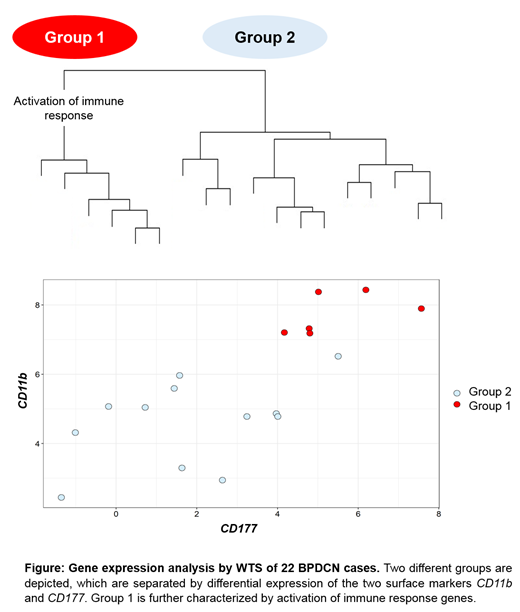Background: Blastic plasmacytoid dendritic cell neoplasm (BPDCN) is a rare hematological malignancy with a poor prognosis. The majority of patients with BPDCN show a complex karyotype. Recurrently mutated genes mainly include epigenetic modifiers and splicing factor genes, however a number of other mutations, many characteristic for myeloid disorders were also detected in BPDCN. Gene expression (GE) profiling revealed an aberrant activation of the NFκB pathway and high expression of BCL2. More recently, rearrangements in MYC were also reported and are associated with an even more aggressive course. However, the exact pathogenesis of BPDCN is still unclear.
Aim: Comprehensive analysis of molecular mutations, structural variations and GE profile in 22 cases with BPDCN by whole genome sequencing (WGS) and whole transcriptome sequencing (WTS).
Methods: WGS and WTS was performed for 22 BPDCN patients. For WGS, 151bp paired-end reads were generated on NovaSeq 6000 machines (Illumina, San Diego, CA). A mixture genomic DNA from multiple anonymous donors was used as normal controls. All reported p-values are two-sided and were considered significant at p<0.05. For GE analysis, estimated gene counts were normalized and the resulting log2 counts per million were used as a proxy of gene expression in each sample.
Results: Median age of the cohort was 74 years (range 16 - 89 years), the majority of patients were male (20/22). After stringent filtering, 112 genes were found recurrently mutated in 22 BPDCN patients. The most frequently mutated genes were epigenetic or splicing factor genes: TET2 (23 mutations (mut) in 15/22 cases, 68%), followed by ASXL1 (7 mut in 7/22 cases, 32%), SRSF2 (7 mut in 7/22 cases, 32%) and ASXL2 (3 mut in 3 3/22 cases, 14%). Moreover, in almost half of the cases (10/22, 45%) a mutation in at least one gene involved in DNA repair (according to Wood et al., Science 2001) was detected: ATM (4 mut in 3 cases), POLH (3 mut in 3 cases), TP53 (2 mut in 1 case), POLE (2 mut in 1 case), REV3L, WRN, MSH6, RAD51C (1 case each). Regarding structural aberrations, deletions of 5q (6/22 cases, 27%), 12p (7/22, 32%), 13q (9/22, 41%), 15q (6/22, 27%) and monosomy 9 (8/22, 36%) were frequently observed. Additionally, we detected gains of 1q and 7q in 4/22 (18%) and 3/22 (14%) cases, respectively. A deletion of TP53 (17p13) was observed in 2/22 (9%) cases. In 4/22 cases (18%) rearrangements involving MYC were observed, the translocation partners were localized on 6p21 (2 cases), 3p24 and 13q14 (1 case, each), respectively.
Unsupervised clustering of the whole transcriptional profiles revealed a segregation of the cohort into two distinct groups (see Figure). Interestingly, one group was characterized by a significantly higher expression of the neutrophil-specific receptor CD177 (HNA2A, NB1, PRV1) and CD11b, indicating the presence of an activated subset of neutrophils. This was supported by the pathway enrichment analysis of the differentially expressed genes between both groups, which revealed activation of immune response as a significantly overrepresented biological process. The bimodal expression pattern of CD177 has often been linked to the presence of various SNPs such as A134T, G156A and G1333A (Moritz et al. 2010), however, analysis of the WGS data did not show such a correlation in our cohort. The CD177 gene promotor contains binding sites for the transcription factor CEBPA, which was significantly up-regulated in group 1 and might contribute to the increased expression of CD177. The expression of CD177 has also been linked to overall survival (OS) (Costa et al. 2017) and, interestingly, patients of group 1 showed a longer OS than patients of group 2 (5.9. vs. 3.6 months, p=0.012).
Conclusions: (1) Our results give further insight into the complex pattern of genetic aberrations in patients with BPDCN: beside the well-described mutations in epigenetic modifiers and splicing factor genes, a large number of mutations in DNA repair genes (e.g. ATM, POLH, TP53, POLE) were detected. (2) In 18% of our cases, rearrangements involving MYC were detected. (3) GE analysis revealed two different subgroups of BPDCN, differentiated by activation of immune response genes and by the two surface markers CD11b and CD177 with an implication on OS. CD177 is well characterized as an immunotarget and recent studies suggest that CD177-mediated nanoparticle targeting might improve cancer immunotherapy (Chu et al. 2016, Miettinen et al. 2018).
Stengel:MLL Munich Leukemia Laboratory: Employment. Walter:MLL Munich Leukemia Laboratory: Employment. Baer:MLL Munich Leukemia Laboratory: Employment. Meggendorfer:MLL Munich Leukemia Laboratory: Employment. Kern:MLL Munich Leukemia Laboratory: Employment, Equity Ownership. Haferlach:MLL Munich Leukemia Laboratory: Employment, Equity Ownership. Haferlach:MLL Munich Leukemia Laboratory: Employment, Equity Ownership.
Author notes
Asterisk with author names denotes non-ASH members.


This feature is available to Subscribers Only
Sign In or Create an Account Close Modal